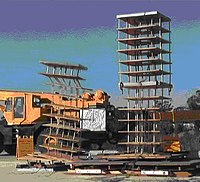
Photo from wikipedia
The present paper reports an experimental study coupled with a numerical modelling approach to simulate masonry walls strengthened with textile-reinforced mortar (TRM). This innovative reinforcing technique is based on high-strength… Click to show full abstract
The present paper reports an experimental study coupled with a numerical modelling approach to simulate masonry walls strengthened with textile-reinforced mortar (TRM). This innovative reinforcing technique is based on high-strength fibre grids embedded into inorganic matrices, and it has recently been promoted for the seismic retrofitting of historical masonry buildings. In the experimental campaign presented here, two different commercial TRM systems are applied to single-leaf clay masonry panels. The specimens are then subjected to diagonal compression tests in order to evaluate the effects of TRM on the structural performance. The proposed finite element (FE) model, based on an original multiscale approach, is employed to simulate the diagonal compression tests. The numerical results show a very good agreement with the experimental data, including in terms of failure mode. In particular, the approach reproduces the macroscopic behaviour of the masonry panels as regards the force-displacement response, and it allows for the possibility of simulating bed joint sliding and TRM layer debonding.
Journal Title: Buildings
Year Published: 2020
Link to full text (if available)
Share on Social Media: Sign Up to like & get
recommendations!